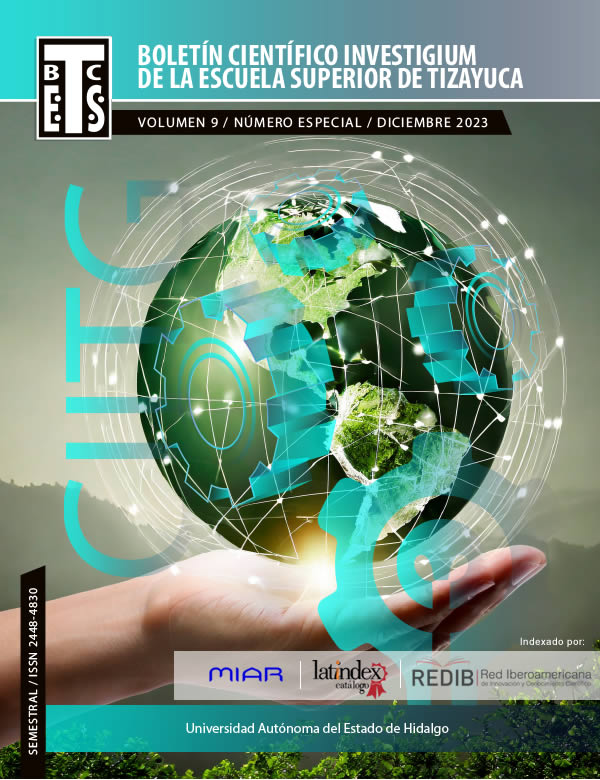Ichthyoplankton community in Coyuca de Benitez lagoon, Guerrero, Mexico.
Abstract
The importance of ichthyoplanktonic studies lies in providing basic elements for the management and sustainable use of fishing resources. The objective of this work was to determine the structure of the ichthyoplanktonic community in the Coyuca lagoon during an annual cycle, monthly samplings were carried out in four seasons, a standard 500 µm conical mesh was used to obtain the samples. The ichthyoplankton composition was characterized through ecological attributes: Shannon diversity index, uniformity index, species richness and the biological value index (IVB). A total of 2673 fish larvae were collected, belonging to nine families, eleven genres and eight species, the most abundant genre being Lile, representing 74.17 % of the total abundance. The temporal abundance presented significant differences between the months analyzed (p<0.05), spatially a higher concentration of fish larvae was reflected in the mangrove areas. The present investigation reflected monthly variations related to the climatic period, spatially the mangroves correspond to high productivity sites conducive to the development and survival of fish larvae.
Downloads
References
Barletta-Bergan, A., Barletta, M. y Saint-Paul, U. (2002). Structure and seasonal dynamics of larval fish in the Caeté River in northern Brazil. Est. Coast. Shelf Sci., 154: 193-206. https://doi.org/10.1006/ecss.2001.0842
Barletta, M. y Barletta-Bergan, A. (2009). Endogenous activity rhythms of larval fish assemblages in a mangrove-fringed estuary in North Brazil. Open. Fish. Sci. J., 2:15-24. DOI:10.2174/1874401X00902010015
CNA y IMTA. (2000). Banco Nacional de Datos de Aguas Superficiales (BANDAS). Base de datos, Secretaría de Medio Ambiente y Recursos Naturales.
CONABIO. (2009). Sitios de manglar con relevancia biológica y con necesidades de rehabilitación ecológica. CONABIO. México DF.
CONAPESCA. (2020). Avisos de arribos de pesca, sitio clave de Captura Lagua de Coyuca 1201103, Subdelegación de pesca en Guerrero, Palacio federal, Acapulco, Guerrero, Mexico.
CONAGUA. (2020). Climatología. Estación 12219, Laguna de Coyuca.https://smn.conagua.gob.mx/tools/RESOURCES/Estadistica/12219
Contreras, F. (1993). Ecosistemas costeros mexicanos. Comisión Nacional para el Conocimiento y Uso de la Biodiversidad. Universidad Autónoma Metropolitana. Unidad Iztapalapa.415 ISBN: 9706203710.
Flores-Verdugo, F.J. (2002). Procesos ecológicos en humedales. En: Abarca L, Herzig F. Manual para el manejo y conservación de los humedales en México. México: SEMADES y U.S. Fish and Wildlife Service Arizona Game and Fish Department Wetlands International the Americas-Program.150
Fuiman, L. E. y Werner, R. G. (2002). Fhisery Science. The unique contributions of early life stages. Oxford, UK: Blackwell Science.325 ISBN: 978-0-632-05661-3
Jiménez-Rosenberg, S.P.A. (1998). Descripción del desarrollo larvario de Eucinostomus gracillis y larvario y juvenil de Eucinostomus dowii y Diapterus peruvianus (Tesis de Maestría en ciencias). Instituto politécnico nacional, Centro interdisciplinario de Ciencias Marinas, La Paz, México.98 p. https://www.repositoriodigital.ipn.mx/
Matarese, A. C., Kendall Jr. A. W., Blood, D.M. y Vinter, B. M. (1989). Laboratory guide to early life history stages of Northeast Pacific fishes. Dep. Commer., NOAA Tech. Rep. NMFS 80:652. https://spo.nmfs.noaa.gov/content/tr-80-laboratory-guide-early-life-history-stages-northeast-pacific-fishes
Moser, H., Charter, R., Smith, P., Ambrose, D., y Charter, S. (1996). The early stages of fishes in the California current region. CalCOFI. Atlas No. 33. Lawrence, Kan.: Allen Press.1517. https://swfsc.noaa.gov/publications/CR/1996/96Mos1.pdf
Navarro-Rodríguez, M.C., González-Guevara, L.F., Flores-Vargas, R., González-Ruelas, M.E. y Carrillo-González, F.M., (2006). Composición y variabilidad del ictioplancton de la laguna El Quelele, Nayarit, México. Revista de Biología Marina y Oceanografía, 41 (1):35-43. http://dx.doi.org/10.4067/S0718-19572006000100006.
Todd, E.S. (1973). Positive buoyancy of air breathing: a new piscine gall bladder function. Copeia (3): 461-464. https://doi.org/10.2307/1443110
Quispe-Becerra, J., (2014). Dinámica espacio-temporal del ictioplancton del Mar Menor (Se España) y factores ambientales asociados (Tesis de Doctorado). Universidad de Murcia Facultad de Biología Departamento de Ecología e Hidrología. 573 https://digitum.um.es/digitum/handle/10201/42699
Suárez-Morales, E. (1994). Comunidades zooplanctónicas de las lagunas costeras. En: De la Lanza Espino G. y Cáceres Martínez C, (Eds). Lagunas costeras y el litoral mexicano. Baja California Sur. 248-268. ISBN:968-896-048-9
Yáñez-Arancibia, A. y Díaz-González, G. (1977). Ecología trofodinámica de Dormitator latifrons (Richardson) en nueve lagunas costeras del Pacífico de México (Pisces: Eleotridae). An. Centro Cienc. Mar Limnol., Univ. Nal. Autón. México 4(1):125-149. http://biblioweb.tic.unam.mx/cienciasdelmar/centro/1977-1/articulo26.html
Yáñez-Arancibia, A., (1978). Taxonomía, ecología y estructura de las comunidades de peces en lagunas costeras con Bocas efímeras del Pacífico de México. Centro Cienc. Del Mar y Limnol. Univ. Autón. México, Publ. Esp., 2:1-306. ISBN: 9685827257
Copyright (c) 2023 Maria de los Angeles Mariano-Benitez, Pedro Flores-Rodríguez, Gorgonio Ruíz-Campos, Carmina Torreblanca-Ramírez, Jesús G. Padilla-Serrato, Roberto C. Almazán-Núñez

This work is licensed under a Creative Commons Attribution-NonCommercial-NoDerivatives 4.0 International License.











